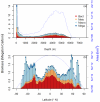Global patterns and predictions of seafloor biomass using random forests
- PMID: 21209928
- PMCID: PMC3012679
- DOI: 10.1371/journal.pone.0015323
Global patterns and predictions of seafloor biomass using random forests
Abstract
A comprehensive seafloor biomass and abundance database has been constructed from 24 oceanographic institutions worldwide within the Census of Marine Life (CoML) field projects. The machine-learning algorithm, Random Forests, was employed to model and predict seafloor standing stocks from surface primary production, water-column integrated and export particulate organic matter (POM), seafloor relief, and bottom water properties. The predictive models explain 63% to 88% of stock variance among the major size groups. Individual and composite maps of predicted global seafloor biomass and abundance are generated for bacteria, meiofauna, macrofauna, and megafauna (invertebrates and fishes). Patterns of benthic standing stocks were positive functions of surface primary production and delivery of the particulate organic carbon (POC) flux to the seafloor. At a regional scale, the census maps illustrate that integrated biomass is highest at the poles, on continental margins associated with coastal upwelling and with broad zones associated with equatorial divergence. Lowest values are consistently encountered on the central abyssal plains of major ocean basins The shift of biomass dominance groups with depth is shown to be affected by the decrease in average body size rather than abundance, presumably due to decrease in quantity and quality of food supply. This biomass census and associated maps are vital components of mechanistic deep-sea food web models and global carbon cycling, and as such provide fundamental information that can be incorporated into evidence-based management.
Conflict of interest statement
Figures










References
-
- Rowe GT, Wei C-L. Biodiversity of Deep-Sea Macrofauna as a Function of Food Supply. In preparation.
-
- Rex M, Etter R. Cambridge, MA: Harvard University Press; 2010. Deep-sea biodiversity: pattern and scale.354
-
- Petersen CGJ. The sea-bottom and its production of fish-food. Report of the Danish Biological Station. 1918;25:1–62.
-
- Petersen CGJ. Valuation of the sea, Part 2. The animal communities of the sea-bottom and their importance for marine zoogeography. Report of the Danish Biological Station. 1913;21:1–43.
-
- Holme N, McIntyre A. Oxford, UK: Blackwell; 1971. Methods for the study of marine benthos. IBP Handbook No. 16.
Publication types
MeSH terms
Substances
LinkOut - more resources
Full Text Sources

